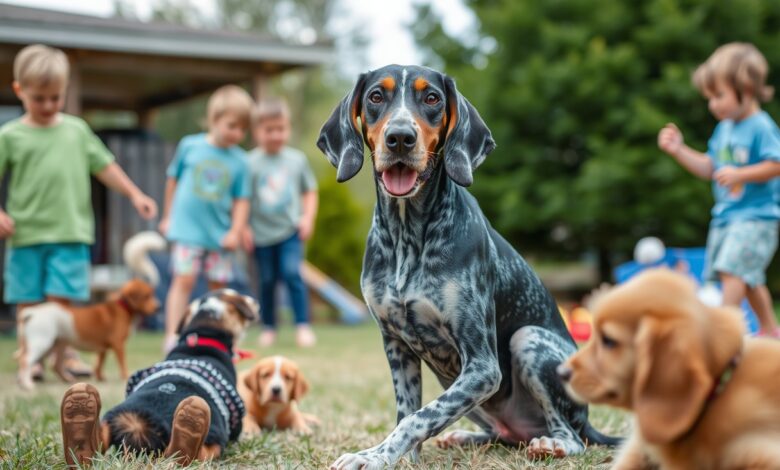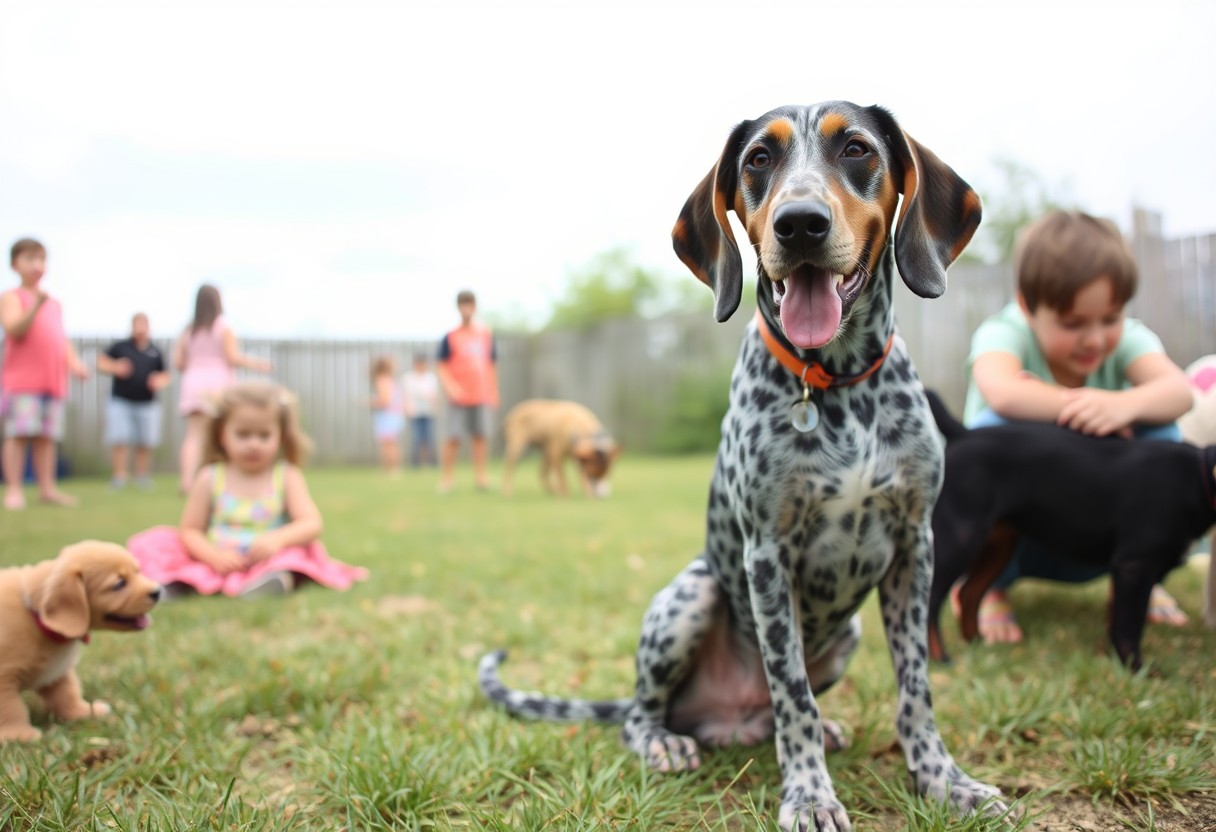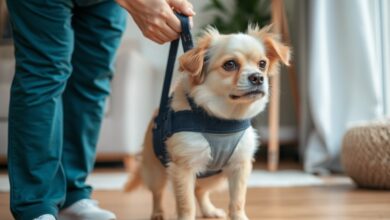Are Bluetick Coonhounds Aggressive? Temperament Guide

Over time, the Bluetick Coonhound has gained a reputation as a loyal companion and skilled tracker, but you may wonder: are these dogs aggressive? Understanding their temperament is crucial for determining whether they are the right fit for your family. While Blueticks are generally known for their friendly demeanor, certain factors like socialization and training can influence their behavior. This guide will help you assess your potential pet’s temperament to ensure a harmonious relationship.

Key Takeaways:
- Temperament: Bluetick Coonhounds are generally known for their friendly and gentle nature, making them suitable family pets.
- Socialization: Early socialization and training are crucial to ensure they do not develop behavioral issues, including aggression.
- Energy Levels: Being an active breed, they require regular exercise and engagement to maintain a calm demeanor and prevent overexcitement or frustration that could lead to aggressive behavior.
Understanding Bluetick Coonhound Types
Before venturing into the intricacies of the Bluetick Coonhound breed, it’s vital to grasp the various types that exist. Here’s a breakdown for you:
| Type | Description |
| Standard Bluetick | Traditional hunting companion known for its endurance. |
| Treeing Bluetick | Specializes in treeing game for hunters. |
| Show Bluetick | Breeds for conformation and adherence to standards. |
| Field Bluetick | Focuses on performance in hunting trials. |
| Crossover Bluetick | A mix of traits for versatility in hunts. |
Perceiving the different types of Bluetick Coonhounds can help you select the right companion that matches your lifestyle.
Different Varieties
The Bluetick Coonhound encompasses several distinct varieties, each possessing unique traits that cater to different preferences and needs in hunting or companionship. Understanding these varieties allows you to appreciate the versatility of the breed and helps you decide which might best suit your lifestyle.
Purpose and Function
There’s a strong emphasis on the purpose and function of the Bluetick Coonhound in hunting communities. These dogs are primarily developed for tracking and hunting purposes, showcasing exceptional agility and scent capabilities. They excel in locating and treeing game, which is vital for a successful hunt.
Another crucial aspect of the Bluetick Coonhound’s purpose is its role as a family companion. While their hunting instincts are dominant, they also possess a gentle side, making them great pets when properly trained. With the right training and socialization, you can ensure that your Bluetick remains balanced, showcasing its affectionate nature while also being a skilled hunter. Understanding this dual role can help you better manage your dog’s energy and instincts, thereby enhancing your relationship.

Factors Influencing Temperament
While evaluating the temperament of Bluetick Coonhounds, several key factors can significantly affect their behavior, including:
- Genetics
- Environment
- Socialization
- Training
Any combination of these elements can contribute to the overall disposition of your dog, emphasizing the need for a holistic approach to understanding their temperament.
Genetics
Temperament is often deeply rooted in a dog’s genetics, and Bluetick Coonhounds are no exception. Their lineage and breeding history can predispose them to particular temperamental traits, such as being more or less aggressive. Understanding the inherited traits of your Bluetick can guide you in providing the right environment and training tailored to their individual needs.
Environment
For raising a well-adjusted Bluetick Coonhound, the environment plays a crucial role. Factors such as living conditions, social interactions, and daily routine can greatly influence their demeanor. A stable, loving home environment supports positive behaviors, while negative experiences can lead to anxiety or aggression.
Understanding your Bluetick’s environment means recognizing that a consistent routine, positive social interactions, and adequate mental stimulation are critical. Providing a safe space where they can explore and socialize encourages your dog to develop confidence and good behavior. Furthermore, exposing your Coonhound to various situations and people can strengthen their adaptability, reducing the chances of aggressive tendencies.

Pros and Cons of Bluetick Coonhounds
Now, understanding the pros and cons of Bluetick Coonhounds can help you determine if this breed is a good fit for your lifestyle. Below is a breakdown of their strengths and challenges:
| Pros | Cons |
|---|---|
| Excellent scent tracking abilities | Strong prey drive |
| Affectionate and loyal | Can be stubborn |
| Great with families and children | Requires regular exercise |
| Strong watchdog instincts | Can be vocal or prone to barking |
| Intelligent and trainable with consistency | May require more socialization |
Strengths and Positive Traits
While Bluetick Coonhounds are known for their hunting skills, they also possess several positive traits that make them great companions. Their loyalty and affectionate nature make them wonderful family pets. You will find their intelligence enables them to learn various commands, especially when consistent training is applied. Additionally, their natural instincts as scent hounds make them superb for tracking and outdoor activities, allowing for a strong bond between you and your dog.
Challenges and Considerations
Now, while Bluetick Coonhounds have many qualities, there are challenges that you should be aware of before bringing one into your home. These dogs have a high prey drive, which means they may chase smaller animals. They can also exhibit stubbornness, making training somewhat difficult at times. Additionally, because they are vocal, their barking could become an issue in certain living situations. Regular exercise is critical to keep them happy and healthy; without it, you may experience undesirable behaviors.
Considerations for owning a Bluetick Coonhound should not be taken lightly. Their strong prey drive might pose a threat to smaller pets, requiring careful introductions. Furthermore, their stubbornness can make training a challenge, so you’ll need to be patient and persistent. Regular exercise is not just recommended; it is vital for their physical and mental well-being. Failing to provide sufficient activity may lead to excessive barking or other destructive behaviors, making it crucial to assess if your lifestyle can accommodate the needs of this active breed.
Tips for Managing Aggression
Now, it’s crucial to implement strategies for managing the potential aggression of your Bluetick Coonhound. Consider the following tips:
- Identify and avoid triggers.
- Provide regular exercise and mental stimulation.
- Teach basic commands for better control.
- Monitor interactions with other animals and people.
- Consult with a professional dog trainer if necessary.
After incorporating these techniques, you’ll be better equipped to address any behavioral issues that may arise.
Socialization Techniques
You must prioritize socialization for your Bluetick Coonhound. Expose them to various environments, people, and other animals from a young age. This practice helps them become more adaptable and less reactive. Regular visits to dog parks, engaging in puppy classes, and arranging playdates can work wonders in developing a well-adjusted temperament.
Training Strategies
Aggression management begins with effective training strategies tailored to your Bluetick Coonhound. Establishing a solid foundation of obedience commands is vital to redirect any aggressive behavior you may encounter. Utilize positive reinforcement techniques like treats and praise to reward good behavior, ensuring that your dog associates obedience with positive outcomes.
Techniques such as desensitization and counter-conditioning are particularly effective in reducing aggression. Start by introducing your Bluetick Coonhound to the triggers of their aggression at a manageable distance. Gradually bring them closer while rewarding calm behavior. Above all, remain patient and consistent with your training to foster a trusting relationship. Do not forget, positive reinforcement promotes long-lasting changes, while harsh methods can exacerbate issues. Create a safe, supportive environment to minimize aggression risks and encourage a loving bond with your dog.
Step-by-Step Approach to Assessing Behavior
Keep in mind that assessing your Bluetick Coonhound’s behavior is crucial for understanding their temperament. Follow these steps to gain insights:
| Step | Action |
| 1 | Observe your dog in different environments. |
| 2 | Monitor their responses to various stimuli. |
| 3 | Assess interactions with other animals and people. |
| 4 | Document any signs of aggression or calmness. |
Observational Techniques
One effective method to assess your Bluetick Coonhound is through keen observation during daily activities. Pay attention to how your dog reacts in different situations, such as meeting new people, encountering other animals, or exploring unfamiliar environments. Note their body language, vocalizations, and overall demeanor to gather insights into their behavior.
Behavioral Assessment
Any behavioral assessment should encompass various aspects of your dog’s interactions and experiences. It’s imperative to evaluate not just aggressive tendencies but also moments of calm and social behavior. Observing your Bluetick Coonhound in diverse settings, from quiet home life to bustling parks, will help you gauge their overall temperament.
It is vital to note that certain behaviors can indicate underlying issues. Look for signs of fear or anxiety, such as cowering or growling, which can escalate to more aggressive responses. Furthermore, your dog might display protective behaviors that, while natural, require cautious handling. The goal is to recognize positive signs of socialization and comfort too—such as wagging tails and relaxed postures—indicating that your Bluetick Coonhound can be a wonderful companion when assessed and trained properly.
Common Misconceptions about Aggression
Despite the reputation of some breeds as aggressive, it is vital to understand that aggression is not a defining trait of the Bluetick Coonhound. Misunderstandings about their behavior often stem from their strong prey drive and vocal nature. These dogs are primarily known for their friendly and sociable temperament, which can easily be misinterpreted as aggression when they exhibit excitement or over-enthusiasm.
Myths Debunked
Aggression is often mistaken for other behaviors in Bluetick Coonhounds. Many people assume that their vocalizations indicate a propensity for aggression, but in reality, they are simply expressing themselves. It’s crucial to distinguish between normal dog behaviors and true aggression to foster better relationships with these loyal companions.
Facts to Know
To truly understand your Bluetick Coonhound’s behavior, it’s important to recognize their social nature and need for proper training. Strong socialization skills and a consistent routine can mitigate any unwanted behaviors, leading to a well-adjusted pet. Be mindful of, a lack of socialization may cause anxiety or fear, but with proper guidance and training, your Bluetick can grow into a loving and friendly companion.
Myths surrounding Bluetick Coonhounds often exaggerate their potential for aggression, overlooking key aspects of their nature. Understanding that Blueticks are generally friendly and enjoy human interaction is vital. Be mindful of, consistent training and positive reinforcement can help shape their behavior and create a balanced environment. Your Bluetick Coonhound’s temperament is also influenced by environmental factors and individual experiences, so proactive socialization is vital in nurturing their friendly and affectionate qualities.
Final Words
With these considerations, understanding the temperament of Bluetick Coonhounds can help you determine if they fit well with your lifestyle. While they are generally friendly and sociable, your individual dog’s behavior will depend on training and socialization. Therefore, it’s vital to invest time and effort in these areas to ensure a well-adjusted pet. For further insights, you might find it helpful to explore What is the temperament of a Black Lab/Blue Tick Coon … to see how their mix might influence personality traits.
Check out these links for more information on the temperament and behavior of Bluetick Coonhounds:
- AKC – Bluetick Coonhound Breed Information
- The Spruce Pets – Bluetick Coonhound Profile
- Love Your Dog – Bluetick Coonhound Temperament
- PetMD – Bluetick Coonhound Overview
FAQ
Q: Are Bluetick Coonhounds aggressive towards humans?
A: Generally, Bluetick Coonhounds are not considered aggressive towards humans. These dogs are known for their friendly and social nature. They are affectionate, loyal, and typically enjoy being around people. However, like any breed, individual temperament can vary based on factors such as socialization, training, and environment. Proper training and early socialization with different people and situations can help ensure that a Bluetick Coonhound develops a well-rounded and non-aggressive personality.
Q: How do Bluetick Coonhounds behave around other animals?
A: Bluetick Coonhounds have a strong prey drive due to their hunting background, so they may exhibit dominance or aggression towards smaller animals, especially if they have not been properly socialized. This breed is known to be generally good with other dogs if introduced correctly, but caution should be taken around non-canine pets like cats or small animals. It’s important for owners to supervise interactions, especially before establishing a well-adjusted relationship through gradual introductions and training to minimize aggressive behaviors.
Q: What can I do to ensure my Bluetick Coonhound has a balanced temperament?
A: To promote a balanced temperament in a Bluetick Coonhound, it’s crucial to provide proper training, socialization, and regular exercise. Starting socialization at an early age by exposing your dog to various people, animals, and environments can prevent fear-based aggression. Consistent, positive reinforcement training will help establish good behaviors and strengthen your bond. Additionally, daily physical and mental stimulation, such as long walks, running, or engaging games, can help channel their energy positively, reducing the likelihood of aggression stemming from boredom or frustration.





